3 Working hours remained almost unchanged in 2013
3.1 Working hours change slowly
The concepts of working hours used in statistics are usual weekly working hours, hours actually worked per week and hours actually worked per employed.
Usual weekly working hours refer to an employee's normal or average weekly working hours in the main job. Regular paid or unpaid overtime is included in the usual weekly working hours of employees. The average of usual weekly working hours is influenced by the form of working hours, i.e. whether full-time or part-time work is concerned.
Hours actually worked per week is the number of hours employed persons have worked in the survey week. Hours actually worked per week are separately inquired about in respect of the main job and secondary job. Paid or unpaid overtime hours are also included in it. On the other hand, holidays, weekdays off and absences for other reasons (e.g. sickness) reduce the hours actually worked per week.
Hours actually worked per employed is an imputed concept, which is obtained by dividing the number of hours worked by all employed during the year by the annual average number of employed. This produces the average hours actually worked per employed. The average hours actually worked per employed is calculated in the same way for employed employees.
Working hours and hours worked fluctuate according to changes in the employment and in the structure of the employee population. For instance, if part-time work becomes more widespread than full-time work, the average weekly working hours decrease. Working hours also vary by industry and occupation, as well as by employer sector. Working hours change quite slowly.
3.2 Commonest working week is 35 to 40 hours
The vast majority (72%) of employees worked a usual week of 35 to 40 hours in 2013. Variations between different employee groups were fairly small. Close on one-third of self-employed persons and unpaid family workers regularly worked 35 to 40 hours per week. (Figure 15.)
Figure 15. Share of persons working a regular week of 35 to 40 hours in the main job by socio-economic group in 2013, %
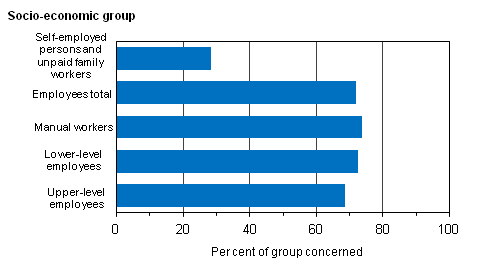
Approximately 18 per cent of employees had a short working week of under 35 hours. Around one in five of lower-level employees worked short hours. Short working weeks were less usual among upper-level employees. Those with a regular short working week most typically worked 30 to 34 hours per week. One self-employed person and unpaid family worker in four did a short working week. (Figure 16.)
Figure 16. Share of persons working a short week of 1 to 34 hours in the main job by socio-economic group in 2013, %
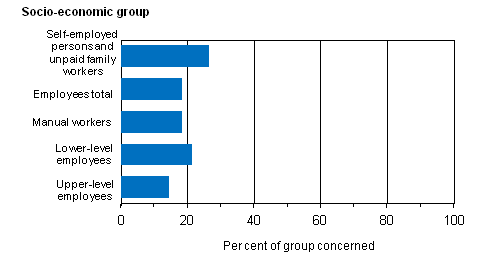
An average of nine per cent of employees worked a long week of over 40 hours. Among all employees, upper-level employees most often worked regularly long hours. Around 17 per cent of them did long weekly working hours. Long usual weekly working hours were most widespread among self-employed persons and unpaid family workers, of whom 44 per cent regularly worked a long week of over 40 hours. (Figure 17.)
Figure 17. Share of persons with long usual weekly working hours of over 40 hours in the main job by socio-economic group in 2013, %
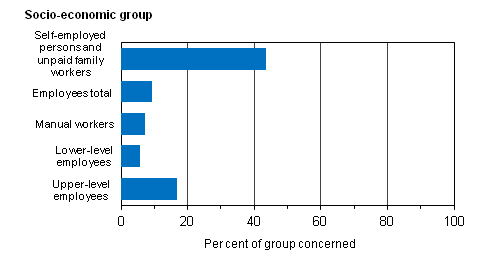
3.3 Men’s working week in full-time employment longer than women’s
In 2013, employees' average usual weekly working hours were 36.3 hours in their main job and their hours actually worked per week were 35.1 hours in their main job. The longest weekly hours were worked by self-employed persons (including unpaid family workers), whose average usual weekly working hours in 2013 totalled 41.1 and hours actually worked per week 40.1 hours. Hours actually worked per week are reduced by holidays and other absences and increased by worked overtime hours.
When examining employees' average usual weekly working hours in their main job, men's usual and actual weekly working hours in full-time employment were longer than for women in 2013 (Table 2).
Table 2. Average of employees’ usual weekly working hours and hours actually worked per week in the main job in full-time and part-time work in 2013
| Usual weekly working hours | Hours actually worked per week | |||
| Full-time work | Part-time work | Full-time work | Part-time work | |
| Genders, total | 39.0 | 19.9 | 37.5 | 19.9 |
| Males | 39.9 | 18.5 | 38.6 | 18.9 |
| Females | 38.0 | 20.5 | 36.2 | 20.3 |
When viewing employees by occupational groups, the average usual weekly working hours of managers in full-time work were around 43.5 hours (Figure 18). Apart from them, only plant and machine operators, and assemblers did a long working week of over 40 hours. Correspondingly, the working week was shortest for clerical support workers, and for service and sales workers.
Figure 18. Average usual weekly working hours of full-time employees in the main job by occupation in 2013
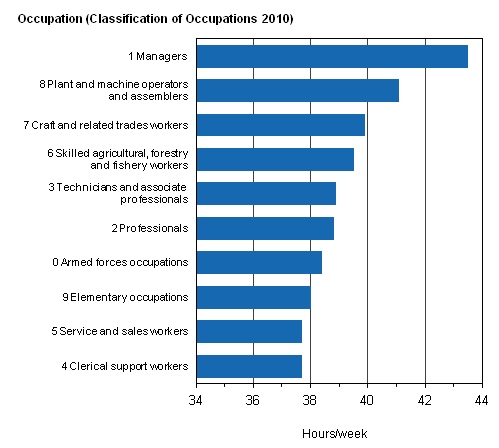
3.4 Hours actually worked remained more or less unchanged in 2013
In the private sector and in central government, the hours actually worked per employed (see explanation of the concept above) have been almost equal in recent years. Hours actually worked in the private sector and in the central government sector decreased slightly in 2013. In the local government sector, the hours actually worked are clearly below those in other sectors. The hours actually worked in the local government sector grew slightly compared to 2012. (Figure 19.)
Figure 19. Employees' hours actually worked per employed by employer sector in 2005-2013
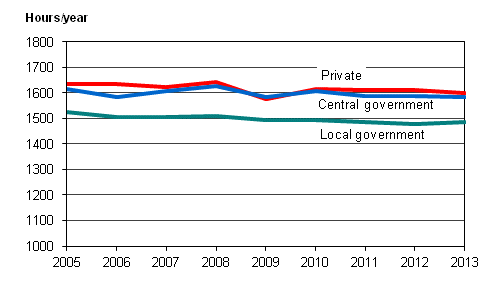
In 2013, the number of hours actually worked per employed was 228 hours lower among female employees than among male employees. For instance, women work part-time more often than men. Two-thirds of all employees working part-time are women. Family leaves also shorten women’s hours actually worked more than men’s.
Source: Labour Force Survey 2013. Statistics Finland
Inquiries: Heidi Melasniemi-Uutela 09 1734 2523, Joanna Viinikka 09 1734 3796, tyovoimatutkimus@stat.fi
Director in charge: Riitta Harala
Updated 1.4.2014
Official Statistics of Finland (OSF):
Labour force survey [e-publication].
ISSN=1798-7857. Employment and unemployment 2013,
3 Working hours remained almost unchanged in 2013
. Helsinki: Statistics Finland [referred: 20.12.2025].
Access method: http://stat.fi/til/tyti/2013/13/tyti_2013_13_2014-04-01_kat_003_en.html

